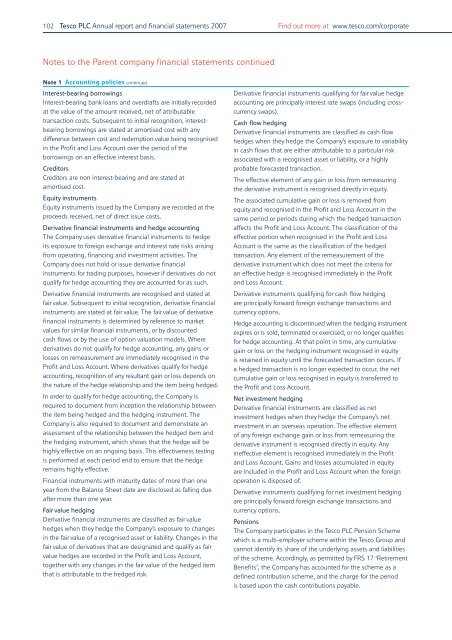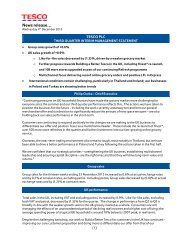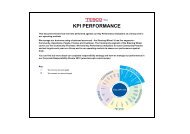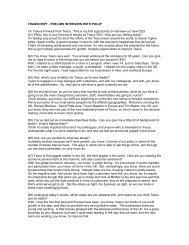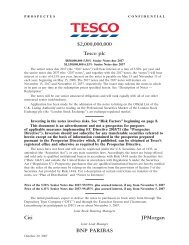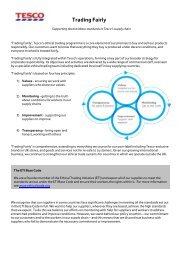Annual Report and Financial Statements 2007 - Tesco PLC
Annual Report and Financial Statements 2007 - Tesco PLC
Annual Report and Financial Statements 2007 - Tesco PLC
Create successful ePaper yourself
Turn your PDF publications into a flip-book with our unique Google optimized e-Paper software.
102 <strong>Tesco</strong> <strong>PLC</strong> <strong>Annual</strong> report <strong>and</strong> financial statements <strong>2007</strong> Find out more at www.tesco.com/corporate<br />
Notes to the Parent company financial statements continued<br />
Note 1 Accounting policies continued<br />
Interest-bearing borrowings<br />
Interest-bearing bank loans <strong>and</strong> overdrafts are initially recorded<br />
at the value of the amount received, net of attributable<br />
transaction costs. Subsequent to initial recognition, interestbearing<br />
borrowings are stated at amortised cost with any<br />
difference between cost <strong>and</strong> redemption value being recognised<br />
in the Profit <strong>and</strong> Loss Account over the period of the<br />
borrowings on an effective interest basis.<br />
Creditors<br />
Creditors are non interest-bearing <strong>and</strong> are stated at<br />
amortised cost.<br />
Equity instruments<br />
Equity instruments issued by the Company are recorded at the<br />
proceeds received, net of direct issue costs.<br />
Derivative financial instruments <strong>and</strong> hedge accounting<br />
The Company uses derivative financial instruments to hedge<br />
its exposure to foreign exchange <strong>and</strong> interest rate risks arising<br />
from operating, financing <strong>and</strong> investment activities. The<br />
Company does not hold or issue derivative financial<br />
instruments for trading purposes, however if derivatives do not<br />
qualify for hedge accounting they are accounted for as such.<br />
Derivative financial instruments are recognised <strong>and</strong> stated at<br />
fair value. Subsequent to initial recognition, derivative financial<br />
instruments are stated at fair value. The fair value of derivative<br />
financial instruments is determined by reference to market<br />
values for similar financial instruments, or by discounted<br />
cash flows or by the use of option valuation models. Where<br />
derivatives do not qualify for hedge accounting, any gains or<br />
losses on remeasurement are immediately recognised in the<br />
Profit <strong>and</strong> Loss Account. Where derivatives qualify for hedge<br />
accounting, recognition of any resultant gain or loss depends on<br />
the nature of the hedge relationship <strong>and</strong> the item being hedged.<br />
In order to qualify for hedge accounting, the Company is<br />
required to document from inception the relationship between<br />
the item being hedged <strong>and</strong> the hedging instrument. The<br />
Company is also required to document <strong>and</strong> demonstrate an<br />
assessment of the relationship between the hedged item <strong>and</strong><br />
the hedging instrument, which shows that the hedge will be<br />
highly effective on an ongoing basis. This effectiveness testing<br />
is performed at each period end to ensure that the hedge<br />
remains highly effective.<br />
<strong>Financial</strong> instruments with maturity dates of more than one<br />
year from the Balance Sheet date are disclosed as falling due<br />
after more than one year.<br />
Fair value hedging<br />
Derivative financial instruments are classified as fair value<br />
hedges when they hedge the Company’s exposure to changes<br />
in the fair value of a recognised asset or liability. Changes in the<br />
fair value of derivatives that are designated <strong>and</strong> qualify as fair<br />
value hedges are recorded in the Profit <strong>and</strong> Loss Account,<br />
together with any changes in the fair value of the hedged item<br />
that is attributable to the hedged risk.<br />
Derivative financial instruments qualifying for fair value hedge<br />
accounting are principally interest rate swaps (including crosscurrency<br />
swaps).<br />
Cash flow hedging<br />
Derivative financial instruments are classified as cash flow<br />
hedges when they hedge the Company’s exposure to variability<br />
in cash flows that are either attributable to a particular risk<br />
associated with a recognised asset or liability, or a highly<br />
probable forecasted transaction.<br />
The effective element of any gain or loss from remeasuring<br />
the derivative instrument is recognised directly in equity.<br />
The associated cumulative gain or loss is removed from<br />
equity <strong>and</strong> recognised in the Profit <strong>and</strong> Loss Account in the<br />
same period or periods during which the hedged transaction<br />
affects the Profit <strong>and</strong> Loss Account. The classification of the<br />
effective portion when recognised in the Profit <strong>and</strong> Loss<br />
Account is the same as the classification of the hedged<br />
transaction. Any element of the remeasurement of the<br />
derivative instrument which does not meet the criteria for<br />
an effective hedge is recognised immediately in the Profit<br />
<strong>and</strong> Loss Account.<br />
Derivative instruments qualifying for cash flow hedging<br />
are principally forward foreign exchange transactions <strong>and</strong><br />
currency options.<br />
Hedge accounting is discontinued when the hedging instrument<br />
expires or is sold, terminated or exercised, or no longer qualifies<br />
for hedge accounting. At that point in time, any cumulative<br />
gain or loss on the hedging instrument recognised in equity<br />
is retained in equity until the forecasted transaction occurs. If<br />
a hedged transaction is no longer expected to occur, the net<br />
cumulative gain or loss recognised in equity is transferred to<br />
the Profit <strong>and</strong> Loss Account.<br />
Net investment hedging<br />
Derivative financial instruments are classified as net<br />
investment hedges when they hedge the Company’s net<br />
investment in an overseas operation. The effective element<br />
of any foreign exchange gain or loss from remeasuring the<br />
derivative instrument is recognised directly in equity. Any<br />
ineffective element is recognised immediately in the Profit<br />
<strong>and</strong> Loss Account. Gains <strong>and</strong> losses accumulated in equity<br />
are included in the Profit <strong>and</strong> Loss Account when the foreign<br />
operation is disposed of.<br />
Derivative instruments qualifying for net investment hedging<br />
are principally forward foreign exchange transactions <strong>and</strong><br />
currency options.<br />
Pensions<br />
The Company participates in the <strong>Tesco</strong> <strong>PLC</strong> Pension Scheme<br />
which is a multi-employer scheme within the <strong>Tesco</strong> Group <strong>and</strong><br />
cannot identify its share of the underlying assets <strong>and</strong> liabilities<br />
of the scheme. Accordingly, as permitted by FRS 17 ‘Retirement<br />
Benefits’, the Company has accounted for the scheme as a<br />
defined contribution scheme, <strong>and</strong> the charge for the period<br />
is based upon the cash contributions payable.


